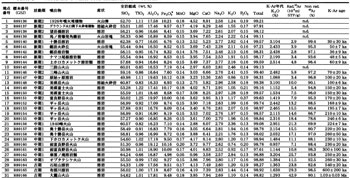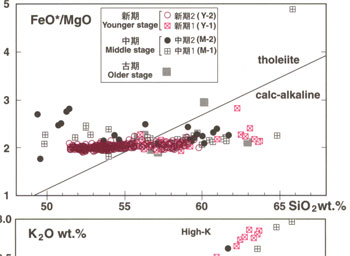Tokachidake Volcano
1: Introduction / 2: Overview of the Tokachidake Volcano Group
3: Eruptive history of the Tokachidake Volcano Group
4: Eruptions in historical times
5: Petrological features of erupted rocks - 6: Sulfur deposit and hot springs
7: Observation of volcanic activities - 8: Points to be noted for mitigation of volcanic disaster
Acknowledgements / References
![]() PREV
PREV ![]() NEXT
NEXT
5: Petrological features of erupted rocks - 6: Sulfur deposit and hot springs
5: Petrological features of erupted rocks
The erupted rocks of the Tokachidake Volcano Group consist mainly of olivine basalt to pyroxene andesite accompanied with small amount of biotite-hornblende dacite. Whole-rock SiO2 range is from 49 to 66 % ( ![]() Table 2 ) and the range of K2O contents extend from medium to high- K fields (
Table 2 ) and the range of K2O contents extend from medium to high- K fields ( ![]() Fig. 6 ). Andesite-dacite belongs to the calc-alkaline rock series.
Basalt to basaltic andesite is distributed in Oputateshikeyama, Biefuji, Shimohorokamettoku, Furanodake, and Maefuranodake volcanoes where are located in the areas in NE, SW, and SE of the Tokachidake Volcano Group. Most of Holocene ejecta are basaltic andesite. Phenocrysts of basalt consist of plagioclase, olivine and clinopyroxene, occasionally accompanied with lesser amount of orthopyroxene. Basaltic andesite contains plagioclase, clinopyroxene, orthopyroxene, and olivine phenocrysts occasionally accompanied with little amount of magnetite phenocrysts. Whole-rock FeO* / MgO ratios of the rocks are over 1.7 and mostly 2 to 2.5. Therefore those are more differentiated as basalt-basaltic andesite.
Fig. 6 ). Andesite-dacite belongs to the calc-alkaline rock series.
Basalt to basaltic andesite is distributed in Oputateshikeyama, Biefuji, Shimohorokamettoku, Furanodake, and Maefuranodake volcanoes where are located in the areas in NE, SW, and SE of the Tokachidake Volcano Group. Most of Holocene ejecta are basaltic andesite. Phenocrysts of basalt consist of plagioclase, olivine and clinopyroxene, occasionally accompanied with lesser amount of orthopyroxene. Basaltic andesite contains plagioclase, clinopyroxene, orthopyroxene, and olivine phenocrysts occasionally accompanied with little amount of magnetite phenocrysts. Whole-rock FeO* / MgO ratios of the rocks are over 1.7 and mostly 2 to 2.5. Therefore those are more differentiated as basalt-basaltic andesite.
Andesite occurs in most of the Tokachidake Volcano Group. Phenocrysts include plagioclase, clinopyroxene, orthopyroxene, and magnetite occasionally accompanied with small amount of olivine.
Dacite occurs at Kaunnotaki Lavas and Tokachidake Lavas. Phenocrysts are plagioclase and common hornblende occasionally accompanied with orthopyroxene and biotite.
In the erupted rocks of the Tokachidake Volcano Group, increases of whole-rock SiO2 contents tend to be accompanied with decreases of TiO2, Al23, and MgO while increases of Na2O, and K2O. FeO* / MgO ratios of the rocks stay almost constant. K2O contents tend to increase with increases of whole-rock SiO2 in the Younger stage rocks as compared to those in the Older and Middle stage rocks. This trend is more conspicuous in rocks of basalt and mafic andesite. This is used as an additional criterion in the classification scheme based on the activity ages employed in this map. No other major components show differences with ages.
6: Sulfur deposit and hot springs
Mining of sublimated sulfur ore began towards the end of Meiji era at the Central crater of the Tokachidake Volcano Group. Both in the 1926 and 1962 eruptions, sublimation and production of sulfur had increased several years before the eruptions. However, mining was halted after 1926 because of the casualties of workers and damage to premises by eruption. Mining was resumed in 1955, but it was completely abandoned after the 1962 eruption.
Hot springs are known to exist at several places in the northwestern side of the Tokachidake Volcano Group. The temperatures of the springs are about 30°C to 45°C. It was reported that the temperature tended to increase before and after the 1988-89 eruption at the Fukiage Hot Spring ( Geological Survey of Hokkaido, 1991 ).

